S&P Global Offerings
Featured Topics
Featured Products
Events
S&P Global Offerings
Featured Topics
Featured Products
Events
S&P Global Offerings
Featured Topics
Featured Products
Events
S&P Global Offerings
Featured Topics
Featured Products
Events
Corporations
Financial Institutions
Banking & Capital Markets
Economy & Finance
Energy Transition & Sustainability
Technology & Innovation
Podcasts & Newsletters
Corporations
Financial Institutions
Banking & Capital Markets
Economy & Finance
Energy Transition & Sustainability
Technology & Innovation
Podcasts & Newsletters
Research — 15 Nov, 2023
A recent Kagan US Consumer Insights survey found that 74% of internet adults experienced extreme weather over the past year, with 68% citing higher electric bills, repair costs or related health issues.

➤ Nearly half (46%) of surveyed internet adults across the US experienced prolonged periods of excessive heat over the past year, with residents of Southern states being the most impacted.
➤ Residents in the South (39%) and the West (31%) were hardest hit by prolonged periods of drought, driving up water and electric bills.
➤ The majority (53%) of those experiencing wildfires over the past year reside in the West, though the resulting smoke caused unhealthy air across the Midwest and Northeast.
➤ Excessive snowfall was experienced in the West and across the Midwest, while approximately half of those experiencing flooding and/or wind damage reside in the South.

Extreme weather events, ranging from searing heat waves to frigid cold, from flooding to extended drought, have become common news headlines in the US over the past year. No geographic region has been spared. With this as a backdrop, the Kagan US Consumer Insights third-quarter 2023 survey asked internet adults to identify the types of extreme weather events they experienced over the past year and how they were impacted by extreme weather.
The survey found that the most prevalent form of extreme weather was excessive heat. Nearly half (46%) of surveyed internet adults reported experiencing a prolonged period of excessive heat during 2023. While only 10% said they experienced wildfires in their local community, one-third (36%) of respondents indicated they were affected by unhealthy air due to distant wildfires. Approximately one-quarter (23%) of consumers experienced a prolonged period of drought this past year, with 14% impacted by either flooding or excessive winds. Relatively few (9%) respondents reported experiencing excessive periods of cold weather or excessive snowfall (6%).
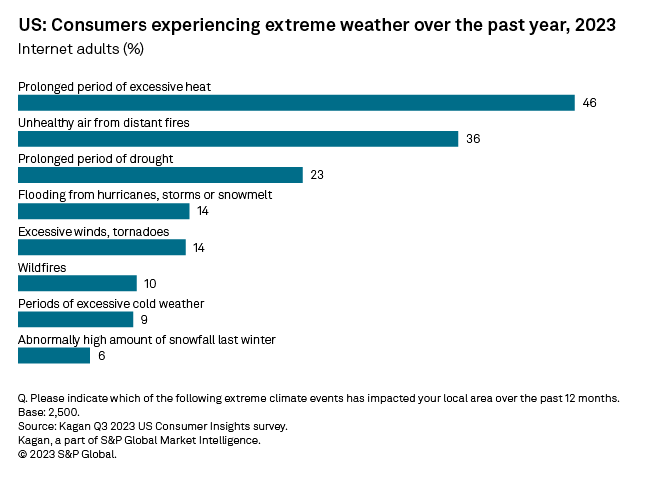
The survey also found that for over two-thirds (68%) of households, the personal impact of extreme weather included higher electric and heating costs, expensive repairs, health issues and even job/income insecurity. Nearly half (43%) of surveyed internet adults said extreme weather has led to higher heating and electric costs. Consumers were also impacted by electric outages or brownouts (21%), higher water costs (20%), or damage to cars (13%) or the home (11%) over the past year.
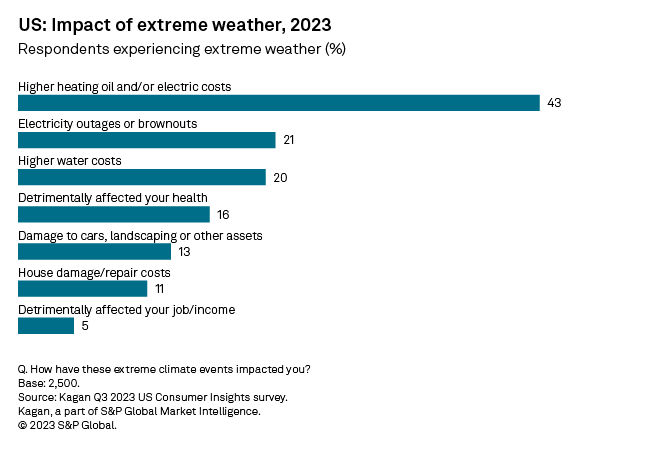
Thirty-nine percent of those who experienced prolonged periods of drought over the past year reside in southern states. Texas was hit especially hard with 56% of respondents from that state reporting extreme drought conditions. The western region was also hit hard by drought, led by Arizona (42%) and California (34%). As a result of extreme drought, one-third (33%) of affected households said they were paying higher water rates.
Southern states, more than other geographic regions, were also subjected to prolonged periods of excessive heat during 2023. Nearly half (45%) of internet adults in the southern region cited excessive heat, including over 60% of survey respondents in Alabama, Louisiana, Florida, South Carolina and Texas. Overall, only 22% of residents in the western region reported excessively hot weather. Yet, even in Arizona, renowned for its long, hot summers, 76% of residents said they experienced a longer period of extreme heat than usual. The majority (53%) of those experiencing excessive heat reported increased electricity costs.
As previously reported, only 9% of internet adults experienced periods of excessive cold weather over the past year. One-third (33%) of these households were in the Midwest region, with Michigan, Wisconsin and Kentucky being the most prevalent. Excessively cold weather has led to higher electricity and heating costs (58%) as well as electric outages (38%).
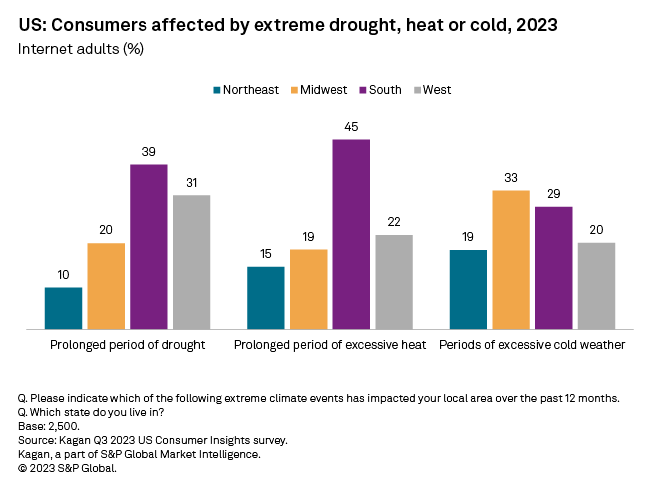
Wildfires are an example of how extreme weather events in one part of the country can detrimentally impact other geographic regions. The survey found that the vast majority of those directly impacted by wildfires over the past year reside in either the West (53%) or the South (27%). However, the smoke from wildfires can spread across the entire country, leaving consumers in the Midwest and Northeast breathing unhealthy air as well. Approximately half (46%) of those experiencing wildfires in or near their local communities said they were impacted by higher electric bills. Wildfires also caused electric outages for one-third (32%) of affected households, along with higher water costs (30%).
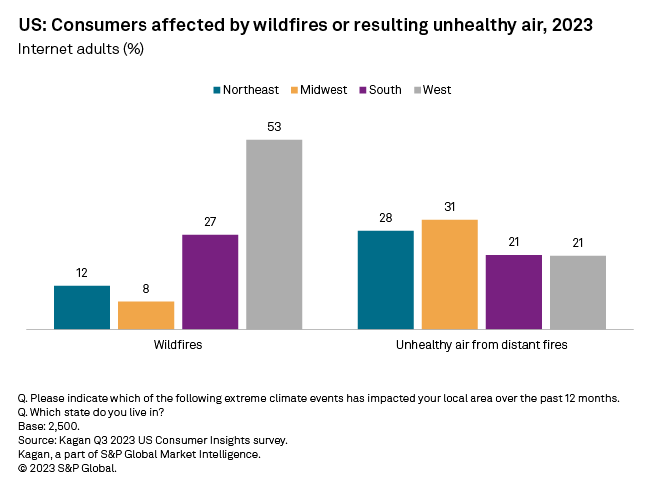
The survey found that abnormally high snowfall was experienced primarily in the West (36%) and Midwest (30%), resulting in higher electric bills and power outages.
Nearly half (48%) of those experiencing major flooding resided in the South, affecting consumers in numerous ways, ranging from higher electric bills to home and car damage. Similarly, 45% of those experiencing excessive winds were located in the southern US, resulting in power outages (41%) as well as damage to homes (24%), cars (24%) and other personal assets.
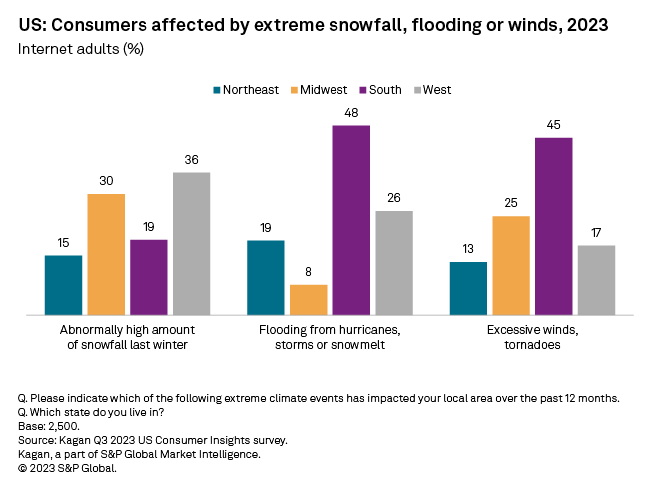
To submit direct feedback/suggestions on the questions presented here, please use the "feedback" button located above, directly under the title of this article. Note that while all submissions will be reviewed and every attempt will be made to provide pertinent data, Kagan is unable to guarantee inclusion of specific questions in future surveys.
Consumer Insights is a regular feature from Kagan, a part of S&P Global Market Intelligence.
This article was published by S&P Global Market Intelligence and not by S&P Global Ratings, which is a separately managed division of S&P Global.